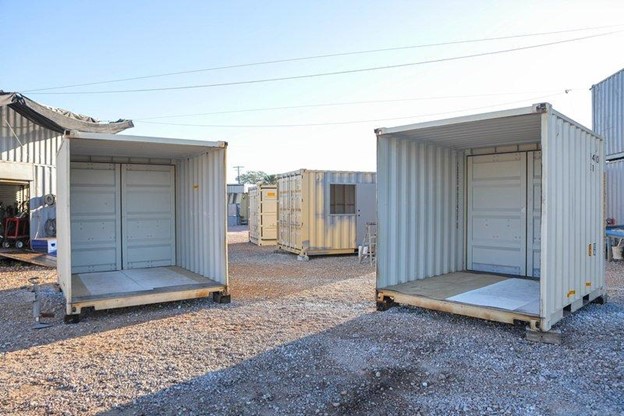Can I Use a Shipping Container as a Shed?
The idea of repurposing shipping containers for various purposes has gained significant popularity over the years. From homes and offices to restaurants and even swimming pools, shipping containers have proven their versatility and sustainability. But one common and practical question that often arises is “Can I use a shipping container as a shed?” In this blog post, we will explore the possibilities and considerations of using a shipping container as a shed, delving into the benefits, potential challenges and tips for turning a container into a functional and cost-effective storage solution.

Understanding Shipping Containers
Before diving into the specifics of using a shipping container as a shed, it’s important to understand what these containers are and their inherent characteristics.
Shipping containers come in various sizes, with the most common being 20 feet and 40 feet in length. They are designed to transport goods across long distances and are built to withstand harsh weather conditions, handling and long journeys on ships, trains, and trucks. This inherent durability makes them an appealing option for repurposing as sheds.
Benefits of Using a Shipping Container as a Shed
- Durability and Security: As mentioned earlier, shipping containers are designed to be robust and weather-resistant. They are typically made of corten steel, which is known for its resistance to corrosion. This means that your belongings inside the container will remain safe from the elements and potential intruders.
- Cost-Effective: When compared to traditional shed construction, using a shipping container can be a cost-effective solution. The container itself is often less expensive than building a wooden or metal shed from scratch.
- Quick Setup: Shipping containers are essentially ready-made structures, which means that you can quickly set up your shed without the lengthy construction process associated with traditional sheds. All you need to do is modify it to suit your needs.
- Eco-Friendly: Repurposing a shipping container as a shed is an eco-friendly choice as it gives new life to containers that might otherwise be scrapped. It also reduces the need for new building materials.
- Mobility: If you need a shed that can be moved, shipping containers can be easily transported to a new location, making them ideal for temporary storage solutions.
- Customizability: Shipping containers can be customized to your specific needs. You can add windows, doors, shelves, insulation and even electrical and plumbing systems if required.
Considerations and Challenges
While using a shipping container as a shed offers numerous benefits, there are also considerations and challenges to keep in mind:
- Size: Shipping containers come in standard sizes, which may not be a perfect fit for your needs. You might need to compromise on space or invest in modifications to make it work.
- Insulation: Shipping containers are designed for transportation, not for human habitation. Therefore, they can be extremely hot in the summer and cold in the winter. Insulation is crucial for making them comfortable for storage or other purposes.
- Local Regulations: Check with your local authorities and building codes to ensure that repurposing a shipping container as a shed complies with regulations. In some areas; it may require permits or certain modifications to be in compliance.
- Modification Costs: While containers themselves can be cost-effective, the cost of modifying them to your specific needs can add up. This includes insulation, ventilation, windows, doors and any other necessary customizations.
- Transportation and Placement: Transporting a shipping container to your property can be a logistical challenge. You’ll need to arrange for delivery and have a suitable spot prepared for its placement.
- Condensation: Containers are prone to condensation, which can lead to moisture problems inside. Proper ventilation and insulation can help mitigate this issue.
Tips for Using a Shipping Container as a Shed
- Plan Carefully: Start with a well-thought-out plan that takes into consideration your specific storage needs and the container’s size.
- Insulate and Ventilate: Properly insulate and ventilate the container to ensure it remains comfortable and moisture-free. Spray foam insulation is a popular choice for insulating shipping containers.
- Customize Thoughtfully: When customizing your container; think about the placement of doors and windows to maximize natural light and ease of access.
- Maintenance: Regular maintenance is essential to ensure the longevity of your container. Keep an eye on any rust or damage and address it promptly.
- Security: Enhance security with sturdy locks and security measures to protect the items you store inside.
- Regulations: Be sure to check with your local authorities about permits and zoning regulations. It’s crucial to be in compliance with local laws.
- Foundation: Ensure you have a stable and level foundation for your container. This can be a concrete pad or a set of concrete blocks, depending on your site.
- Consider Shelving: Depending on your storage needs adding shelving or racking inside the container can help maximize the use of space.
Creative Uses for Shipping Container Sheds
While most people use shipping containers as traditional storage sheds, there are various creative ways to repurpose them:
- Workshop: Transform your container into a workshop or hobby space where you can engage in DIY projects, woodworking, or other creative endeavors.
- Home Gym: A container shed can serve as a home gym, providing a dedicated space for your workout equipment.
- Art Studio: Artists can turn a shipping container into a secluded art studio, offering an inspirational and peaceful place to create.
- Pool House: If you have a pool, a shipping container can be converted into a stylish pool house with changing rooms and storage for pool supplies.
- Greenhouse: By adding windows and a controlled environment, you can use a shipping container to house a small greenhouse for gardening.
- Guest House: With the right modifications and plumbing, a shipping container can become a unique and cozy guest house or tiny home.
Conclusion:
In conclusion; using a shipping container as a shed is a practical and cost-effective solution for storage and various other purposes. While it offers several benefits, it’s essential to consider the challenges such as customization, insulation, and local regulations. With careful planning and thoughtful modifications, a shipping container can become a durable, eco friendly and versatile structure that serves your specific needs. Whether you’re looking for a traditional storage shed or a creative space for a hobby or business, a shipping container might just be the answer you’ve been seeking.







Leave a Comment
You must be logged in to post a comment.